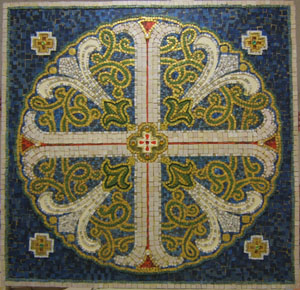 The mosaic icon designed by Chris Gosey and assembled with the help of parishioners contains much Christian symbolism, in the colors and shapes as well as the materials used to construct it.
The mosaic icon designed by Chris Gosey and assembled with the help of parishioners contains much Christian symbolism, in the colors and shapes as well as the materials used to construct it.
In general, the colors take on the following meanings: blue for the heavenly realm, the place where God lives; green for the growth given us through the Holy Spirit; gold for the light of Christ that shines over the world and imbues it with spiritual knowledge; white for the purity given us as a gift during baptism; and red for Christ’s redeeming blood and for the fire of the Holy Spirit that burns away sin and gives new life in Him.
In several areas of the mosaic, stained glass from windows in the original church was crushed to provide color and texture. It was crushed rather than cut into small pieces because the areas where it’s used are very small.
“I think it has a nice quality to it. Frosted, crumbled, jewel-like,” said Chris. “Since the church as grown and as it reaches out, this mosaic is a way of remembering the past. It’s important that this cross is a reliquary for that part of the old church building.”
Growth at Holy Cross is also represented in the pieces of stained glass left over from the construction by Alice St. Hilaire of the stained glass art in the worship space windows. “There’s also a bringing about of the new in the use of Alice’s new glass,” Chris said. The amber glass, which is also crushed, will tie the mosaic to the window art through color when the icon is displayed.
In the center of the mosiac are five stones representing, Chris says, the five crucifixion wounds of Christ. Four amber stones placed around the five center gems symbolize the four writers of the Gopels. And the four red rays streaming from the center remind us, Chris says, “of the proverbial four corners of the earth. They remind us that where there is sin, the blood of Christ must be taken.”
The four lilies represented in each quadrant are symbols of Easter and stand for Jesus’s risen presence. The vine work throughout the icon is indicative of the cross itself. “They represent the tree of life and how our new life in Christ is eternal and unending,” Chris said.
The words of the four Gospels going out to all the world to redeem it are symbolized by the four small crosses in each corner of the mosaic.
The whole image is set into a blue background that proclaims, Chris says, “that the things of God are now among us and they sanctify us.” The complete design is an original by Chris and was inspired by a book cover about Francis of Assisi. The center design was inspired by Byzantine jewelry and also by the quadrifoil crosses that appear on the old altar from the original church, which is now used in the new church’s entrance and gathering space. “It was another way to connect to the past and honor the holiness of all the work that has gone on before,” Chris said.
This project has received financial support from Terry Knowles. Thank you, Terry!
Christopher Gosey graduated from Texas A&M University in 1985 with a B.A. in Environmental Design. After five years of experience in the areas of Church Design, Historic Preservation and Adaptive Reuse, he made the transition from intern Architect to Iconographer.
Though Gosey embraced Russian Orthodox Christianity in 1988, it was not until he began worshipping with Boston’s Ethiopian Orthodox community that his work took on a more intense direction. While the Moscow School of Russian iconography is firmly grounded in the Byzantine Iconographic tradition, Ethiopian iconography is heavily influenced by Western religious art, but strongly Byzantine in flavor.
Ethiopian iconography includes greater modeling of faces, the use of bright, exotic and richly patterned clothing, and the bold, loose use of black outlining. Because of his expertise in these various Iconographic traditions, Gosey has been a guest lecturer at the Harvard Divinity School, the International Society of Gilders and Harvard’s School of Middle Eastern Studies.
In 1992, Gosey founded Holy Images, a studio specializing in the creation of quality Orthodox iconography. Check out Chris’s website: http://www.holyikons.com/